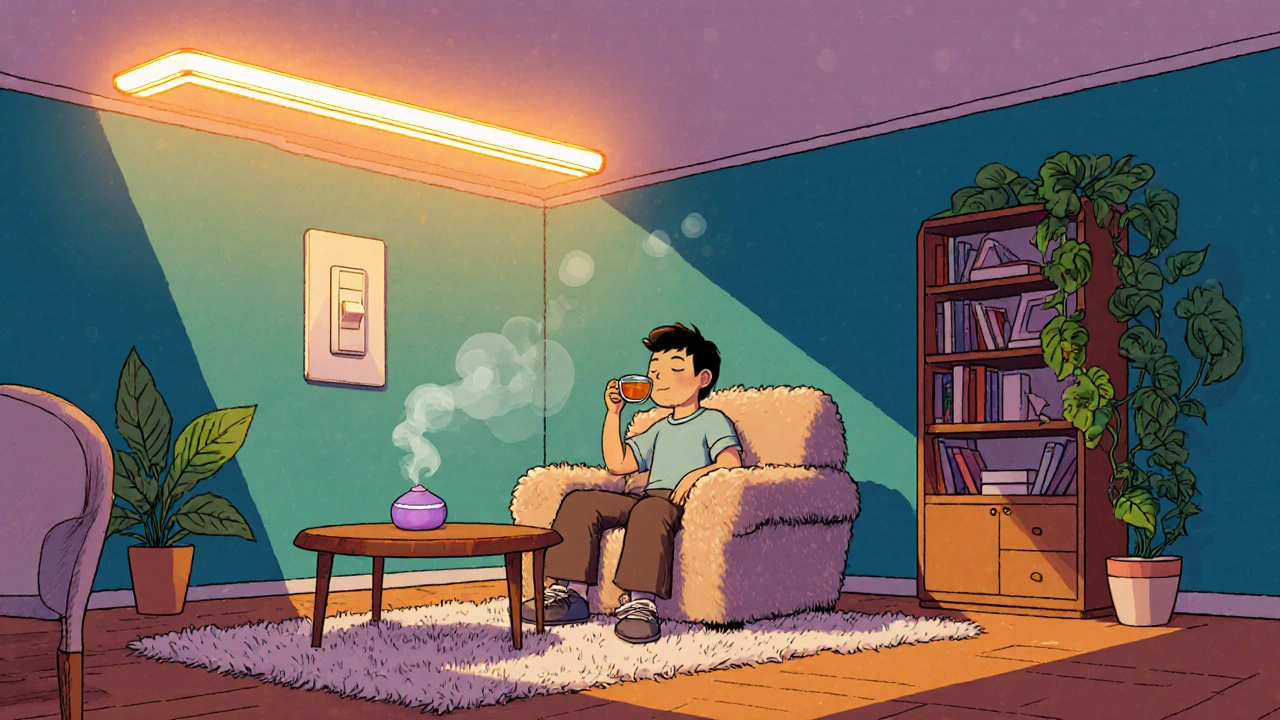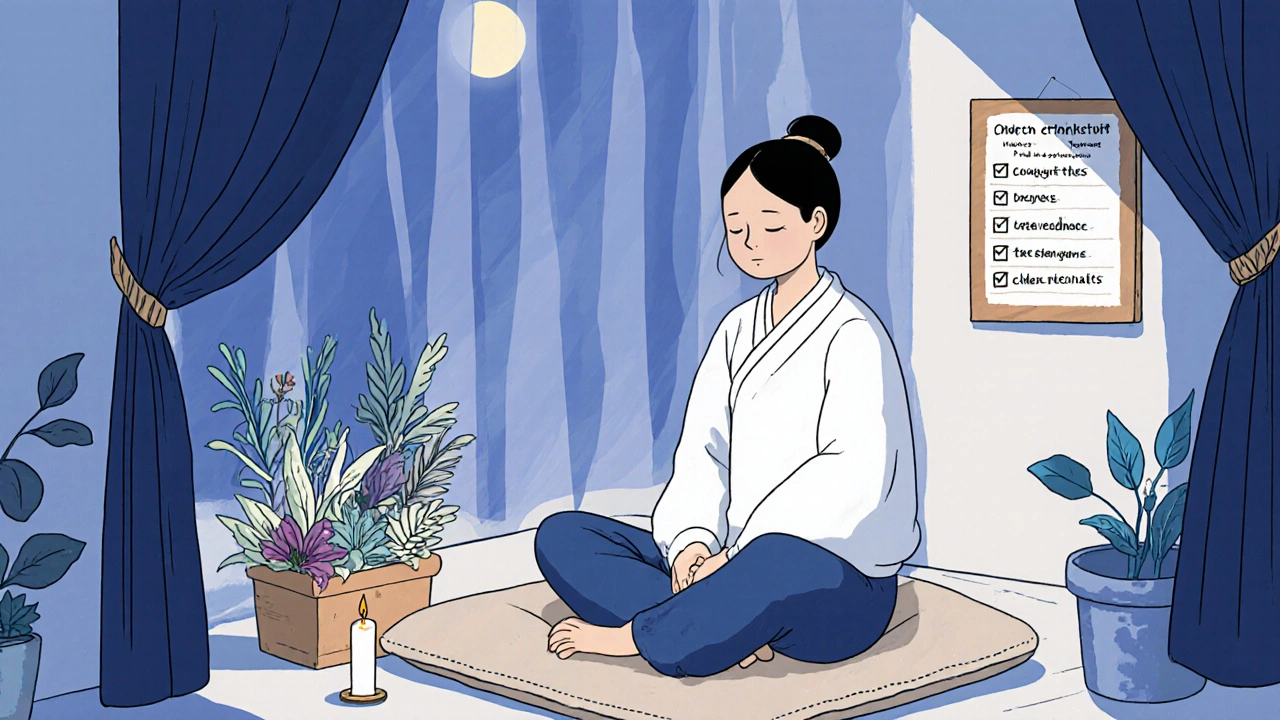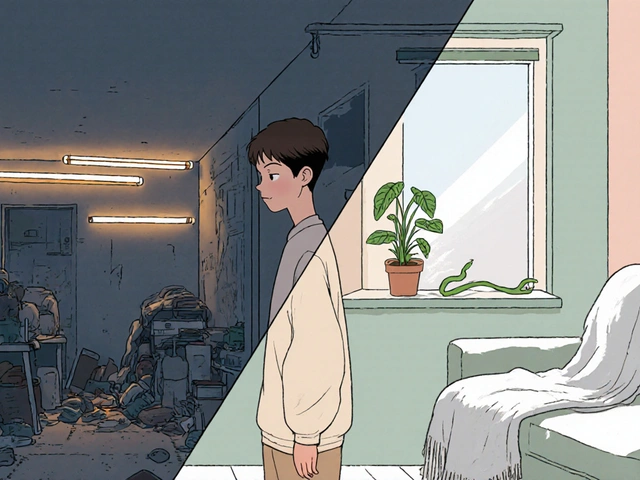Home Comfort Assessment Tool
Take this quick assessment to identify your home's comfort strengths and areas for improvement. Your results will provide personalized suggestions for creating a more calming space.
Feeling like the world is constantly testing your patience? You’re not alone. In a world that feels wired for tension, carving out a pocket of comfort at home can feel like a rebellion. Below you’ll discover practical, down‑to‑earth ways to turn your living space into a sanctuary that restores your energy, lowers stress, and makes everyday life feel a little softer.
What Comfort is a state of physical and mental ease that helps you feel at peace Really Means
Comfort isn’t just a fluffy buzzword-it’s a measurable boost to your wellbeing. Studies from the University of Sheffield show that people who rate their homes as “comfort‑focused” report 30% lower cortisol levels after a stressful day. In simple terms, a comfortable home helps your body dial down the fight‑or‑flight response, letting you unwind faster.
Assess Your Space: A Quick Comfort Audit
Before you buy new pillows or paint the walls, take a moment to see what’s already working and what’s not. Grab a notebook and walk through each room, asking yourself:
- Does the space feel cluttered or open?
- Are lights harsh or soothing?
- Is the temperature stable, or does it swing wildly?
Jot down the biggest irritants. This audit gives you a roadmap of where to focus your energy first.
Light and Lighting the arrangement of light sources that affect mood and visual comfort
Bright, flickering fluorescence can raise anxiety. Swap out harsh bulbs for warm‑tone LED strips (2700-3000K) and add dimmers where possible. If you have a window that lets in natural light, keep the view clear-no heavy drapes that block daylight.
Choose a Soothing Color palette a set of colors used in interior design to influence mood
Research from the Royal College of Art suggests that cool blues and muted greens lower heart rate, while soft neutrals like warm greys create a sense of grounding. Paint one wall in a calming hue, or add accessories-throw pillows, rugs, curtains-in these shades to gently shift the room’s vibe.

Invite Nature: Plants living greenery that improves indoor air quality and visual calm and Biophilic design an approach that incorporates natural elements into built environments
Even a single pothos or snake plant can boost oxygen levels and cut indoor pollutants by up to 25%. Place them where you’ll see them-by a reading chair or on a kitchen windowsill. If you have space, create a mini indoor garden with a mix of foliage textures for visual interest.
Scent and Sound: Aroma therapy the use of essential oils to promote relaxation and wellbeing & Soundscapes ambient sounds that help the brain unwind
A few drops of lavender or eucalyptus in a diffuser can lower blood pressure within minutes. For sound, try a low‑volume playlist of rain, ocean waves, or soft instrumental music. If you’re on a budget, a smartphone app with nature sounds works just as well.
Control Temperature control methods to keep indoor climate stable and comfortable and Add Texture the tactile quality of fabrics and surfaces that affect physical comfort
Keep your thermostat in the 68-72°F (20-22°C) range for most people. If you can’t afford a smart thermostat, use a programmable timer for heating and cooling. Add texture with soft throws, plush rugs, or a textured wall panel to give the room a cozy, tactile layer.
Declutter: The Power of Clutter excess items that create visual and mental noise Management
Every extra item competes for visual attention, raising stress. Follow the “one in, one out” rule: whenever you bring something new home, donate or discard an existing piece. Use storage baskets and clear containers to hide away items you don’t need daily.

Mindful Habits: Mindfulness the practice of staying present and aware of thoughts and sensations at Home
Set aside five minutes each day to simply sit in your favorite spot, breathe, and notice the sensations around you-soft cushions, warm light, scent of a candle. This tiny habit trains your brain to associate the space with calm.
Quick Comfort Checklist vs. Deep Comfort Upgrade
| Aspect | Quick Checklist | Deep Upgrade |
|---|---|---|
| Lighting | Swap harsh bulbs for warm LEDs | Install dimmers, add layered lighting (ambient, task, accent) |
| Color | Add one calming throw pillow | Repaint a feature wall, incorporate a consistent palette |
| Plants | Place a single low‑maintenance plant | Create a dedicated indoor garden corner |
| Scent | Use a plug‑in diffuser with lavender oil | Curate a scent rotation (citrus, wood, herb) and add scented candles |
| Sound | Play a low‑volume nature playlist | Install soft‑surface flooring, add acoustic panels |
| Temperature | Set thermostat to 70°F (21°C) | Upgrade to a programmable smart thermostat, add ceiling fans |
| Clutter | Clear visible surfaces | Implement organized storage solutions, adopt minimalism |
| Texture | Add a soft throw | Layer textures across furnishings and wall finishes |
| Mindfulness | 5‑minute breathing pause daily | Design a dedicated meditation nook |
Putting It All Together: Your Action Plan
- Do the quick audit and list three biggest discomfort sources.
- Pick one item from the Quick Checklist and implement it today (e.g., swap a bulb).
- Choose one deeper upgrade to schedule for the next weekend (e.g., paint a wall).
- Commit to a nightly 5‑minute mindfulness pause in your newly comfort‑enhanced spot.
- Re‑assess after two weeks-has your stress level dropped?
Small wins stack up. By the time you’ve tackled the deeper upgrades, your home will feel like a genuine refuge, and you’ll notice the ripple effect on work, relationships, and sleep.
Frequently Asked Questions
How much money should I budget for a comfortable home?
You can start with under £100 by swapping bulbs and adding a plant. A full deep upgrade often runs between £500‑£1500, depending on size and materials.
Do I need a smart thermostat to improve comfort?
No. A programmable timer on a regular thermostat works well. Smart features are a bonus if you like remote control.
What are the best low‑maintenance plants for beginners?
Snake plant, pothos, and ZZ plant tolerate low light and irregular watering.
Can scent really lower stress?
Yes. Lavender and chamomile have been shown in clinical trials to reduce cortisol by up to 15%.
How often should I declutter to keep comfort levels high?
A quick 10‑minute tidy each evening and a deeper sorting session monthly works for most people.


Eli Soler Caralt
Honestly, I find that curating a sanctuary is akin to crafting a personal manifesto for the soul 🤔.
The subtle alchemy of warm LEDs and muted greens is not just décor-it’s an existential statement about who we aspire to be 😌.
While the guide offers pragmatic steps, I’d argue that the true comfort lies in the intentionality behind each choice, not merely the aesthetic veneer.
A few well‑placed plants become philosophical companions, reminding us of growth amidst stagnation.
Definately, the act of decluttering is a ritual of self‑purification; plese, treat it as such.
Eryn Wells
Your reflection captures the essence of mindful living beautifully 🌿.
It’s refreshing to see someone celebrate the humble act of swapping a bulb as a form of self‑care.
Inclusive spaces thrive when we honor both grand gestures and tiny habits alike.
Keep spreading the calm vibes, they’re contagious! 😊
erica fenty
Leverage ambient lumens to optimize circadian rhythm; the ROI on comfort is quantifiable!!!
Integrate biophilic design metrics-photosynthetic index, air‑purity factor, and acoustic dampening coefficients-into your upgrade plan.
Short‑term adoption yields long‑term cortisol reduction.
eric smith
Oh, brilliant-because we all need a PhD in interior engineering just to replace a lamp. 🙄 Your 'quick checklist' clearly masquerades as a masterclass in overcomplication.
Erika Thonn
In the quiet alcove of our modern dwellings, the pursuit of comfort becomes a silent sermon to the weary mind.
When we pause to audit the spatial energy, we are not merely counting chairs and lamps, but deciphering the hidden dialogues between walls and souls.
The first photon that filters through a sheer curtain whispers a promise of serenity, yet too often we drown it in harsh fluorescence.
A single pothos, with its trailing vines, can serve as a green philosopher, reminding us that resilience thrives in low‑light corners.
The scent of lavender, diffused gently, functions as an olfactory hymn, lowering cortisol as if the air itself were a soothing balm.
Temperature stability, often overlooked, is the thermostatic heartbeat that syncs our bodies with the home’s rhythm.
Texture, from plush throws to rustic wood, offers tactile narratives that coax the nervous system into relaxation.
Clutter, on the other hand, speaks in a cacophony of visual noise, each stray object a tiny stressor amplifying the overall tension.
By embracing the ‘one in, one out’ principle, we enact a cycle of renewal that mirrors natural ecosystems.
Mindfulness pauses, even five minutes, act as micro‑meditations, anchoring our awareness to the present materiality.
When we intertwine these elements-light, plant, scent, temperature, texture-we compose a symphony of calm.
Research from Sheffield, albeit modest, aligns with this holistic view, showing measurable drops in cortisol under comfort‑focused conditions.
Thus, the home transforms from a mere shelter into a sanctuary, a womb of recuperative energy.
Implementing these steps does not demand a fortune; a modest budget can yield profound shifts.
Ultimately, the true investement lies in the intetion to honor ourselves within these walls, a gesture as priceless as the peace it cultivates.
Jake Hayes
Your plan lacks measurable KPIs; without data, comfort remains a vague aspiration.
Brandy Eichberger
The quintessential aesthetic you described elevates the humble abode to a gallery of personal wellbeing.
I adore how the guide balances empirical research with poetic nuance, making the journey both scholarly and accessible.
Your emphasis on layered lighting and texture resonates deeply with my own design philosophy.
Thank you for curating such an inspiring roadmap-cheers to a more serene living experience!
Kathrynne Krause
Absolutely, Brandy! 🌈 Let’s paint this vision with bold strokes of optimism and sprinkle in a dash of creative chaos.
Imagine a living room where the rug sings of sunrise hues and the cushions whisper stories of distant seas.
Together we can turn each comfort tip into a vibrant celebration of life’s simple joys.
Keep the momentum flowing!
Chirag Muthoo
I commend the thoroughness of the presented comfort strategies.